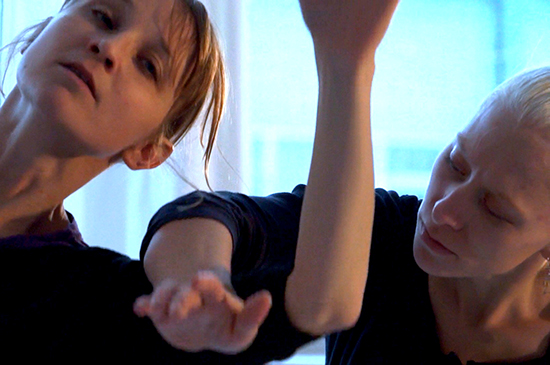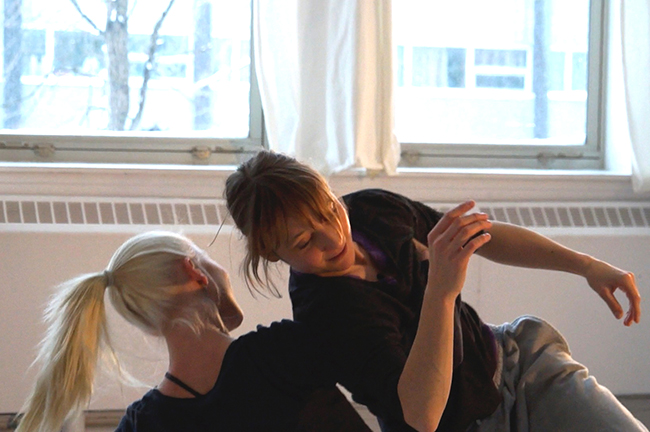Creation by Angela Blumberg

Creation
Choreography: Angela Blumberg
Composers: Norbert Palej, Domenic Jarlkaganova, Augusto Monk
Performers: Angela Blumberg, Sarah Fregeau, Kaitlin Standeven, Jillian Peever
Lighting Design: James Kendal
Trinity St.-Paul’s Centre, Toronto
March 18 & 20, 2016
REVIEWED BY BEVERLEY DAURIO
In Creation, Angela Blumberg showed three linked and inter-reflective pieces that shared a clarity of choreography and a closely interwoven collaboration between music and dance.
The first piece, Veni Creator Spiritus, is a solo based on music written in response to Pope John Paul II's Letter to the Artists. Blumberg, dressed in a silvery suit of pants and collarless, buttonless shirt, makes mostly horizontal curved and straight lines under plain wash lighting, using slides across the floor, and angularity of elbows and knees that seem to explore the music from the inside. Blumberg is by turns demure and meditative, always focused and energetically present. In the second movement of this piece, uprightness is explored, again with precise arms and legs and a feeling of joy and delight in repeated cycles.
The second piece, Creation, works from newly commissioned contemporary classical music by composer Dominic Jarlkaganova. Two dancers, Sarah Fregeau and Kaitlin Standeven, alternately ignore, reject, conflict and interact with each other. The sprinkly spiky soundscape has almost a science-fiction feel, and the dancers duel with one another in an otherworldly way, sometimes in an ominous and harsh manner, struggling, then resting on the floor.
The third piece, The Four Seasons, was created for use in elementary schools, and was substituted into the program we saw as a replacement for a new work, Evolution (which will be shown in this summer's Fringe Festival) because one of the dancers in Evolution was ill and could not perform.
The Four Seasons is an exploration of winter, spring, summer, and fall in dance. Two dancers, Blumberg and Jillian Peever, lean into each other with intimacy and affection. They track and trail an imaginary forest in pleasantly geometric movement with a sense of playfulness. The reaction to the music is not programmatic, but infused with its melancholy and delight, lifted and supported by it. Sudden moments of simultaneity are very charming. At times they roll like elfin creatures at play, walk like rag dolls propping each other up, or lug each other around as they explore the space limberly.
Blumberg's past work has sometimes included multimedia, puppetry, drama, and experimentation that pushes the edges of dance. The pieces in this show feel like a submersion in pure dance, of a kind of distillation of the line of continuous intersection between music and movement. The physical vocabulary is evocative, uncomplicated, and recurrent, in the same way that in a piece of music, a new musical motif will return in a different key, or to be explored by different instruments.


